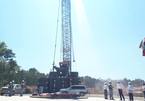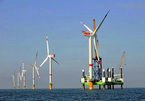Nearly three years have passed since the Prime Minister's Decision 39 dated September 10, 2018 on wind power prices was issued, with the offshore wind power price over VND2,223/kWh (US$9.8 cent/kWh), but no offshore wind power project has kicked off yet.
 |
Many foreign and domestic investors have surveyed and conducted research on offshore wind power in Vietnam. They have said the price of over VND2,200/kWh is “acceptable”. However, three years is still a short time for these projects to be implemented in reality, while this incentive price will end in two months.
Many offshore wind power investors are holding their breath waiting for the next move of the Ministry of Industry and Trade and the Government. Will the feed-in tariff (FIT) for offshore wind power continue to be applied, or immediately move to the bidding phase as planned?
Representing investors, Liming Qiao, Asia Regional Director of the Global Wind Energy Council (GWEC), expects that the Ministry of Industry and Trade and the Government of Vietnam will allow offshore wind power projects with a capacity of 4,000- 5,000 MW to he supported through the FIT, instead of projects with a capacity of 2,000-3,000 MW by 2030, as in the draft power plan 8.
GWEC's research shows that it is the choice of each country to apply FIT or instant bidding. Taiwan and the Netherlands also applied bidding after the period of using FIT for offshore wind power. Meanwhile, France, the new market for offshore wind power development, adopted competitive bidding from the start.
In Vietnam, the FIT mechanism is also applied to offshore wind power projects, but three years is not enough for projects of this kind. According to experts, an offshore wind power project is only economical if the scale reaches 4,000-5,000 MW/project, with an investment capital of $800 million - $1 billion USD or more. The time of implementation takes about five to seven years.
Foreign investors worry that if the bidding mechanism is implemented right away Vietnam may face obstacles as France experienced. Offshore wind power is a very new industry in Vietnam, and the domestic supply chain is also extremely limited.
Unforeseen challenges
 |
At this time, the application of FIT or bidding is still unclear. A "clear policy" is what many investors are waiting for. Mainstream representative said that they are ready to start phase 1 of the 1,400MW Phu Cuong wind power project in the southern province of Soc Trang when there is a clear policy from the Government.
Investors believe that, after the end of the Feed in Tariff mechanism in November 2021, Vietnam needs a new momentum. The country should continue to apply the FIT mechanism for the first 4,000-5,000 GW projects to ensure the stability of the market during the transition to the bidding mechanism. Because the first projects are very risky, they need policy support.
However, whether bidding or FIT are applied, offshore wind power development will face many challenges. In particular, capital mobilization is a problem because these projects need huge capital. Therefore, having access to international capital is very important, which requires clear, stable and predictable policies.
In addition, will foreign investors accept to cut output when there is a local oversupply of electricity at some periods of time, as it is happening for onshore wind and solar power projects?
According to Bernard Casey, Development Director of Mainstream Vietnam, cutting output will make it difficult for investors raising capital, because it creates an unpredictable element in terms of revenue. Most offshore wind power projects have to mobilize capital, so it must go through a rigorous appraisal process by banks and insurance companies before signing a contract.
He said that capacity reduction can only be accepted in a short period of time and with a clear commitment.
Sean Huang, Development Director of Copenhagen Offshore Partner (COP), which invests in La Gan offshore wind power project, said that when signing a power purchase agreement (PPA), capacity cutting must be defined, including estimated output cut for force majeure. But the rate is usually small, and otherwise, measures to protect investors should be taken into account, such as compensation. In Taiwan, if the output cut is high, they will extend the term of the power purchase agreement to make up for the output cut.
Luong Bang

Wind power project developers want FIT extension
Since many wind power projects may not be put into commercial operation prior to October 31, the Prime Minister and Ministry of Investment and Trade have been asked to extend the feed in tariff (FIT) application.

Pandemic challenges wind power projects in Mekong Delta
Several wind power projects currently under development in the Mekong River Delta area are rushing to complete and start operating on a commercial basis before the November deadline,